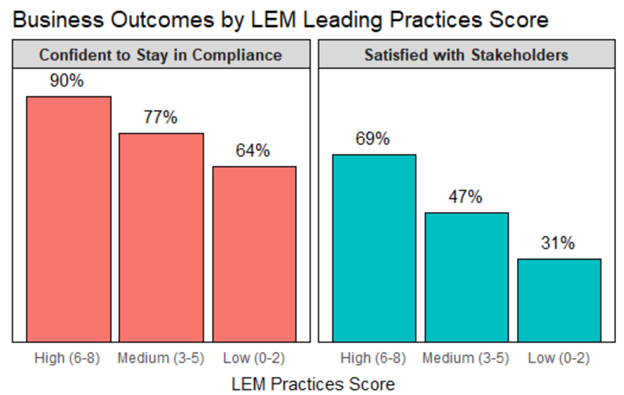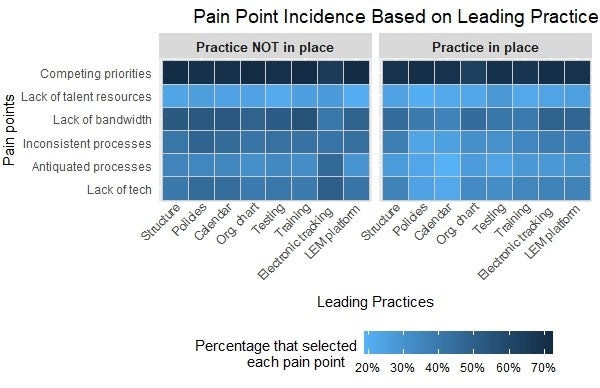In a globalized and interconnected economy, companies large and small face the challenges of having to comply with obligations in multiple jurisdictions, heightened and more diverse reputational risks, and reevaluating operating models and complex governance structures.
As such, legal entity management (LEM) is becoming a salient topic in this increased regulatory environment organizations all over the world must operate in.
To learn more about how legal entity management is handled from the perspective of the legal department, ACC, in collaboration with Deloitte Tax LLP, recently published the report An Inside Look at Legal Entity Management Practices. This comprehensive report studied LEM team structures, policies, procedures, and practices that organizations employ to manage corporate entities and regulatory obligations.
Organizations that implement a series of key leading LEM practices experience better business outcomes than those who do not.
The full report includes detailed results and insights on:
- Global LEM teams’ staffing, budget, and geographical scope;
- Policies and procedures that companies have in place to handle corporate governance;
- Use of technology to support LEM activities;
- Relevant challenges that LEM professionals face; and
- Immediate priorities for LEM teams across all types of organizations.
One of the report’s key findings is that organizations that implement a series of key leading LEM practices experience better business outcomes than those who do not.
LEM leading practices score
ACC identified a set of eight leading practices that constitute a solid approach to effectively managing corporate entity governance.
| Leading Practices | |
| 1 | Centralized, dedicated LEM team is in place |
| 2 | Written LEM policies and procedures are in place and followed |
| 3 | There is a single compliance calendar across the organization |
| 4 | Organizational chart is updated at least quarterly |
| 5 | LEM testing, monitoring, and auditing are conducted regularly |
| 6 | LEM training and educational programs are provided |
| 7 | Corporate records are tracked electronically |
| 8 | Legal department uses LEM technology platform |
By combining the scores for each of these eight practices, we calculated an overall “LEM Leading Practices Score” for each survey participant ranging from zero (none of the leading practices are followed) to eight (all eight practices are in place).
The distribution of LEM Leading Practices scores approaches a normal distribution, with most participating organizations following some, but not all, of the leading practices. Both the mean and median of the survey population were four, resulting in the average legal department following roughly half of the eight leading practices listed.
ACC then evaluated whether there were differences in business outputs between those organizations with a high number of leading practices in place and those that have fewer procedures in place, and the differences were remarkable.
Implementing LEM leading practices results in better business outcomes
Corporate entity management leaders were overwhelmingly confident about their organization’s ability to stay in compliance with regulators, and they were also more likely to be satisfied with their company’s leadership and stakeholders being sufficiently attuned to subsidiary management processes from a governance perspective, as shown in the following chart.

While most participants were at least somewhat confident that their organization would have the ability to stay in compliance, the differences based on the company’s Leading Practices Score are relevant: 90 percent of those on the upper end of the score range were very or somewhat confident, compared with just 64 percent of those with two or fewer leading practices in place.
The results are also very clear when looking at the satisfaction with company stakeholders’ awareness of corporate governance processes. Seven in ten of those with a high score were very satisfied or satisfied with the company’s leadership role in LEM, while less than half of those with a medium score were satisfied, and only 31 percent of those with a score of up to two points.
In addition, those who implemented at least seven of the eight leading practices were less likely to experience delays in updating their corporate records and were less likely to have their entities be out of good standing with regulators.
Companies not following LEM leading practices experience more pain points
Similarly, companies that do not follow LEM leading practices tend to experience pain points to a larger extent. The following tile chart shows the percentage of respondents that selected each of six different pain points related to corporate entity management based on whether they have each of the eight leading practices in place or not.

Darker tiles indicate a larger percentage of respondents selecting the pain points listed on the vertical axis, while lighter tiles indicate a lower percentage of incidence for a particular pain point. Competing priorities is the main pain point experienced by all participants, while lack of talent resources does not concern most participating organizations.
The incidence of not having leading practices in place across the remaining options provided is rather noticeable. Those who do not have leading practices in place are more likely to say that lack of bandwidth is an issue.
Those who do not have leading practices in place are more likely to say that lack of bandwidth is an issue.
More specifically, those who do not have written policies and a single compliance calendar are substantially more likely to select antiquated and inconsistent processes and lack of technology as pain points compared to participants that do have written policies and a single compliance calendar.
Also, respondents who do not track corporate records electronically report antiquated processes and lack of technology as two pain points that they experience to a significantly larger extent than participants in organizations that use technology to track corporate records.
Learn more about legal entity management
The full survey report contains more detailed insights on the positive impact that implementing LEM leading practices has on other business outcomes.
Other relevant key findings relate to the growing focus on LEM based on staffing numbers and budgeting, the worrying discontent of survey participants with the LEM technology platforms available, and the struggles that many companies face in terms of establishing solid LEM policies and practices.
Learn more about this and other recent ACC Research projects on our survey reports and benchmarking web pages.




